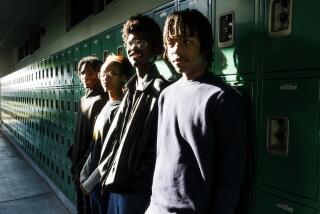Speak Softly and Carry an Open Mind : Program Helps Students, Teachers and Parents Resolve Conflicts Calmly
- Share via
George Hernandez realized last week that he needed a little help in controlling his temper, after getting into a knock-down, drag-out fight with his sister over who was supposed to do the dishes.
“I got mad at my sister because it was her turn to do the dishes, and she said she was not going to wash them, so I ended up having to do them,” said the 13-year-old seventh-grader, who told the story Thursday to 25 classmates at Roosevelt Middle School in Oceanside. “I got so mad that I threw her out of the bed and pulled her hair real hard.”
For Lori Rosario, another seventh-grader, the realization came after her sister refused to wash the family dog as planned.
“My sister and I are supposed to take turns washing the dog, but she didn’t want to do it, and I just got madder and madder at her and started to yell,” said Lori, 12.
George’s and Lori’s siblings may not have to worry about such angry outbursts much longer thanks to the youngsters’ participation in a school project geared toward helping young people and teachers solve disputes in a positive way.
The Resolving Conflict Creatively Program is a national project aimed at training schoolchildren and teachers to deal passively with prejudice, taunts, verbal abuse and other anger-inducing situations that could have potentially violent results.
Students are taught how to become mediators in violent situations, by acting out confrontations and coming up with peaceful solutions in a classroom setting.
The project also schools teachers in intervention and helps parents learn more about how to solve conflicts with a fair hand.
The program is the first of its kind in California, and, since making its debut at Roosevelt six weeks ago, teachers and others say they have noticed quite a change in the youngsters who used to solve problems by yelling at the top of their lungs or by hitting.
“We are looking to teach kids that there is a different way of fighting,” Assistant Principal Janet Dutrey said. “I put out wars every day as an assistant principal, and we know kids have to change. They are already starting to learn what conflict means by going from a language full of put-downs to one of positivity.”
“I still need to practice looking at another person’s point of view more often,” 12-year-old Gabriel Duran said. “But a lot of us have now learned that we all have the same problems when we get angry.”
The 8-year-old nationally renowned project was originally designed to help stem the flood of violence in New York City public schools and to help students, teachers and parents handle stressful situations by first thinking about the consequences of violence.
But directors say the program is now serving an even greater purpose by helping stem the rising level of violence among young people.
Because of drug abuse, gangs and peer pressure, youngsters today have more intense problems and a more difficult time solving them with logic and reason, according to national program coordinator Linda Lantieri.
“We have grown up in a society that has literally institutionalized bias toward people of color, people who are not as able as others or people who choose to have a different orientation,” she said. “It isn’t that the kids have become desensitized; it is that we have taught them to be less sensitive in this violent society, where television bombards them with brutal images on a daily basis.”
The program works on three levels: First, teachers are taught creative conflict resolutions during 20-hour training sessions in intergroup relations and decision-making skills. Afterward, they will teach a 45-week, schoolwide class on those subjects.
The after-school and weekend classes are voluntary, and teachers may or may not get a stipend, depending on the school district, Lantieri said.
Next, a group of students are chosen by their peers to become “Young Ambassadors,” student mediators who will attempt to calmly settle disputes among classmates.
The group takes a class composed of youngsters from different ethnic groups and religious backgrounds. In addition, the kids cover a wide behavioral spectrum--from those who seldom cause problems to those who usually do.
The mix is to ensure that children at every behavioral level learn to deal with stressful situations non-aggressively, Lantieri said.
Finally, parents sign up for four-day classes in conflict-resolution skills to make sure that what children learn in the classes will be implemented at home, Lantieri said.
They are paid $8 an hour to attend the training sessions, and one parent is selected to become a future teacher of other parents.
Roosevelt Middle School was selected for the program after an assistant principal attended a workshop Back East on prejudice and resolving conflict, Lantieri said.
In addition to the Oceanside school, the nationwide program reaches 70,000 kids at all grade levels in 150 schools in New York, St. Louis and Anchorage, she said.
The program, which is funded by individual school districts across the country, costs about $25,000 a year, she said.
But, in the long run, students say that what they have learned is priceless.
“I have learned that you cannot judge a person by their color or what they look like on the outside,” 11-year-old Kyle Walker said. “People are all the same inside.”
More to Read
Sign up for Essential California
The most important California stories and recommendations in your inbox every morning.
You may occasionally receive promotional content from the Los Angeles Times.










